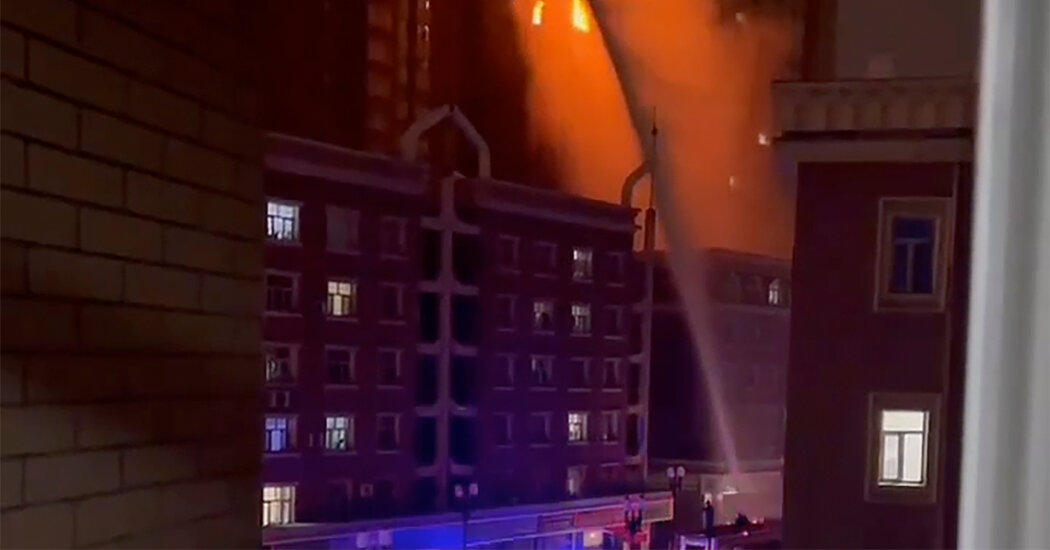Ten people were killed and nine injured when a fire broke out at an apartment building in Xinjiang, a region in China’s far west, where Covid-19 lockdowns have housebound many residents for more than three months.
The fire started Thursday evening on the 15th floor of an apartment building in the Jixiangyuan district of Urumqi, the capital of Xinjiang, the city’s fire department said. It later rose to engulf the two floors above, with smoke billowing further up, the department said on its official account on Weibo, a Twitter-like social media platform.
The fire was started by a power strip catching fire in a bedroom on the 15th floor, state media reported. Firefighters extinguished the fire about three hours later, reports said. Authorities said the dead and injured, who were taken to hospital, had inhaled toxic fumes.
The fire sparked a flurry of questions on Chinese social media about whether Covid restrictions had hindered the rescue or prevented residents from escaping their apartments or the building. Much of Xinjiang, a region of 25 million people, has been under lockdown for more than 100 days as part of the authorities’ heavy-handed response to the Covid outbreaks. In some cases, the lockdowns have left residents in dire straits, with difficulty obtaining food and other necessities, such as medicines and menstrual supplies.
According to state media reports, the Jixiangyuan neighborhood where the fire took place was a “low-risk management” area, a category of lockdown that allows residents to leave their buildings, provided they monitor themselves and avoid large gatherings.
But many Chinese internet users were skeptical of the official account. They shared what appeared to be screenshots of conversations between the government and residents of the Jixiangyuan community, which revealed that the compound had recently been placed under a tighter lockdown, which could have made it more difficult for residents to get to safety.
Chinese commentators also pointed to video footage of what appeared to be attempts to put out the fire as evidence that a lockdown had slowed the effort. The footage showed pressurized water from a fire hose spraying just out of reach of the burning building, suggesting fire engines may not have been able to get closer to the building because the community was on lockdown.
The accounts circulating on social media could not be immediately verified. Xinjiang is an ethnically divided region where the government cracks down on Uighurs, Kazakhs and other largely Muslim minorities. Residents, especially those of Uyghur descent, often face reprisals for speaking to the foreign media.
But the descriptions of residents who may have been confined to their homes or buildings fit a broader pattern of how such closures have been enforced in many parts of the country. Makeshift barricades and locked doors have become an important part of efforts to prevent people who may have been exposed to the virus from leaving their rooms and buildings.
An officer from a nearby police station in Urumqi, who was reached by phone on Friday, said they had no comment and referred reporters to official announcements. Other community workers who could be reached by phone also declined to comment.
Uyghur activists outside China who have sought to draw attention to the prolonged detention of people in Xinjiang said the tragedy pointed to authorities’ failure to protect residents.
“People are not allowed to go out easily without government permission,” said Tahir Imin, a Uyghur academic based in Washington, DC. “My frustration is that the government is handling it very badly. They have shown that they don’t care about the lives of the Uyghurs. How can the fire brigade not get this under control in three hours in a country like China with all its facilities and equipment and people?”
Online, Chinese internet users expressed their anger and sadness, sharing articles with titles such as “Last night’s fire in Urumqi is the nightmare of all residents of Xinjiang.” They distributed black and white images calling for a moment of silence to “express deep condolences to the 10 compatriots who died in the Urumqi fire”. Some residents offered their apartments to families who had lost their homes in the fire.
Questions about the cost of China’s zero-tolerance approach to fighting Covid pose a challenge to China’s leader, Xi Jinping, as he enters his precedent-defying third term in office. Anger over lockdowns and widespread fear of the virus have sparked major protests by thousands of workers in the southern city of Guangzhou and Apple’s largest iPhone factory, Zhengzhou, in central China over the past two weeks.
China has been grappling with an increase in Covid outbreaks, with cases across the country reaching record highs – though still low by global standards. Friday’s tally approached 32,700 cases, with nearly 1,000 recorded in Xinjiang.
The Urumqi fire was the second major tragedy reported this week. On Monday, a fire at a factory belonging to an industrial equipment manufacturer in Henan province killed 38 people, one of the deadliest fires in years.
“In recent years, it has become rare for fire accidents to cause more than 10 deaths,” said Cai Weida, a lawyer and fire safety expert in China. Mr. Cai said that given the small scale of the fire, firefighters’ response had been unusually slow. He attributed delays to a lack of maneuvering space for fire engines, the unique challenges of a high-rise fire, and “roadblocks.”
Chris Buckley reporting contributed.

